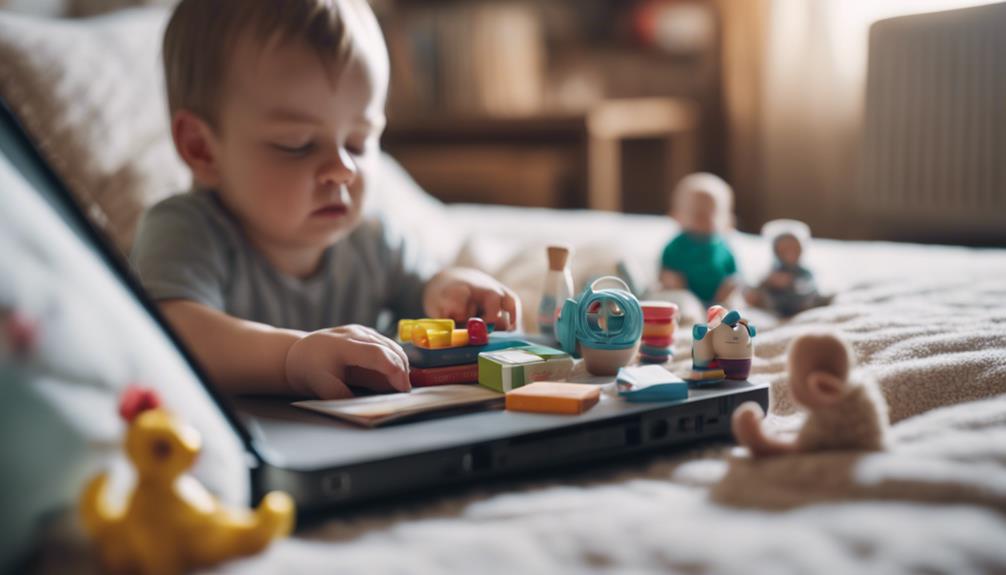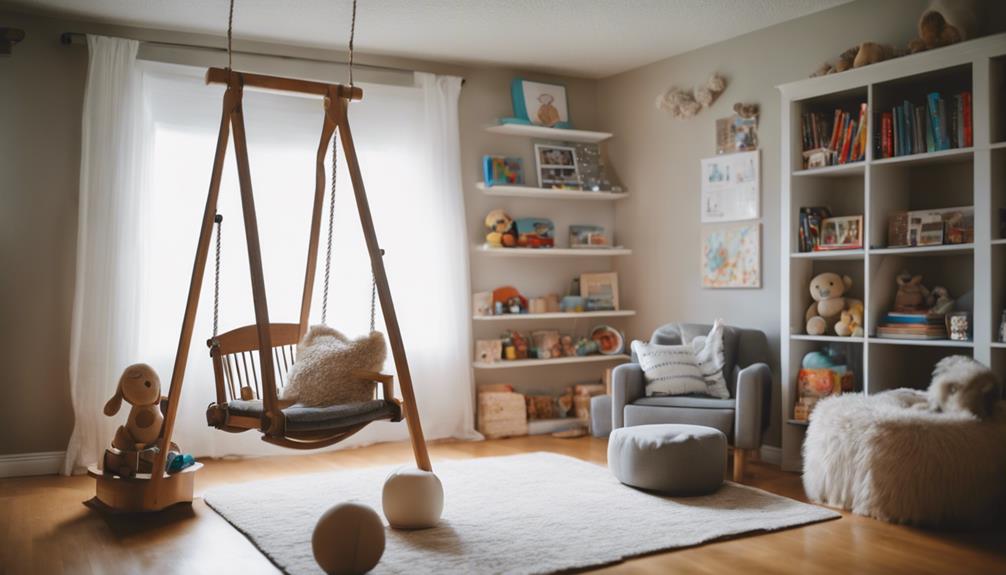When homeschooling with a baby, it’s important to establish a flexible routine that balances education and caregiving. Plan activities during nap times to focus on learning. Utilize baby carriers for hands-free schooling and involve older siblings in baby care. Create a supportive environment with organized school areas and engaging toys. Remember to embrace flexibility and adjust routines to meet the baby’s needs. Prioritize key subjects and quality over quantity. Keep in mind that not every day will go as planned, so practice patience and grace. By following these practical strategies, you can create a harmonious learning environment while caring for your baby.
Key Takeaways
- Plan educational activities during baby's nap times for focused learning.
- Embrace flexibility to juggle baby care and academic tasks effectively.
- Utilize baby carriers for hands-free schooling convenience.
- Foster a supportive environment for both the baby and older kids.
- Prioritize essential subjects like reading, math, and writing for efficient learning.
Establishing a Flexible Routine
When homeschooling with a baby, it's important to establish a flexible routine that can accommodate your little one's needs while also incorporating structured learning activities.
Adapting to your baby's schedule is essential. Plan educational activities during nap times to guarantee focused learning opportunities. Use these moments wisely to engage older children in learning as well.
Make the most of feeding and care times by involving your kids in educational tasks. Incorporate hands-on learning materials that are easily accessible during baby care routines. These materials can facilitate interactive learning experiences for your children.
Creating a supportive environment that allows for interruptions and adjustments is critical. Embrace the flexibility needed to balance caring for your baby and homeschooling effectively.
Utilizing Baby Carriers and Siblings

To efficiently manage homeschooling with a baby, consider utilizing baby carriers and involving older siblings in caring for the little one. Baby carriers are a valuable tool for hands-free schooling, enabling you to multitask effectively during homeschooling sessions.
By involving older siblings in baby care, you not only lighten your load but also foster a sense of responsibility and teamwork within the family dynamic. Opt for carriers like Moby or LÍLLÉbaby for a comfortable and secure babywearing experience. Distribute weight effectively in carriers to reduce strain and discomfort while balancing homeschooling and caring for your baby.
Embrace the convenience of babywearing to engage in focused learning activities while keeping your little one close. This approach allows you to bond with your baby while also ensuring that your homeschooling endeavors remain productive and efficient.
Incorporating Learning During Nap Times

During your baby's nap times, consider incorporating short, focused learning activities to make the most of these quiet moments. Plan educational tasks that can be easily paused and resumed, aligning with your baby's nap schedule.
Utilize this time for quiet reading sessions, independent assignments, or online modules to maximize productivity and efficiency in your homeschooling routine.
Nap Time Activities
Make the most of your baby's nap time by incorporating educational activities that promote learning and engagement. Use this precious time to engage in focused learning activities with your older children, such as reading together, working on puzzles, or playing educational games.
Plan quiet and engaging activities that can be done independently during your baby's nap time to guarantee a productive learning environment.
Utilize nap times for one-on-one teaching sessions with your older children, providing them with individualized attention and tailored learning experiences. Incorporate hands-on learning activities like sorting, counting, or simple experiments to make the most of these valuable moments.
By maximizing nap times for educational purposes, you can create a structured learning routine that benefits both your baby and older children.
Remember to adapt the activities to suit each child's interests and academic needs, ensuring a well-rounded and engaging learning experience during nap times.
Quiet Learning Materials
Utilize quiet learning materials like books, puzzles, and educational apps to promote independent learning during your baby's nap times. These activities are essential for maintaining a peaceful environment while ensuring your little one's rest is undisturbed. Here is a table showcasing some quiet learning materials that can be beneficial during nap times:
| Quiet Learning Materials | Description |
|---|---|
| Books | Engage in silent reading sessions with educational books. |
| Puzzles | Work on puzzles that require focus and concentration. |
| Educational Apps | Explore interactive and educational apps for learning. |
Creating a Supportive Environment

To establish a supportive environment for homeschooling with a baby, make sure that you designate a quiet, organized school area with engaging toys and activities for your little one. Reserve special toys solely for school time to maintain the baby's interest and involvement.
Encourage independent play in a playpen during school hours to facilitate focused learning. Establishing a routine for quiet time with engaging activities can create a conducive learning environment.
It's important to foster a supportive and nurturing atmosphere for both the baby and older kids during homeschooling. By setting up designated spaces and providing engaging activities, you can create an environment that's conducive to learning for all involved.
Prioritizing Essential Tasks

Focus on key subjects such as reading, math, and writing to guarantee academic progress while homeschooling with a baby. Prioritize quality over quantity when planning lessons to secure academic progress. Streamline lessons by focusing on essential concepts that align with your child's educational goals. Integrate baby care tasks into your daily routine to secure productivity and create a balanced environment. Embracing flexibility in your schedule will allow you to accommodate both your child's needs and essential academic tasks.
| Prioritize Quality | Integrate Baby Care Tasks | Embrace Flexibility |
|---|---|---|
| Focus on key subjects | Incorporate baby care tasks into your routine | Be open to adjusting schedules |
| Streamline lessons | Maximize productivity by multitasking | Adapt to your baby's changing needs |
| Ensure effective learning | Create a balanced environment | Accommodate both academic tasks and baby care |
Remember to take breaks when needed to avoid burnout and maintain a healthy balance between homeschooling and caring for your baby.
Practicing Patience and Gentleness

To excel in homeschooling with a baby, remember to stay calm under pressure, be kind and understanding, and embrace flexibility and grace.
Patience is key as you navigate the challenges of balancing your baby's needs with your homeschooling responsibilities.
Stay Calm Under Pressure
During moments of stress, practice deep breathing techniques to maintain a calm and collected demeanor with your baby. Remember that babies can sense your emotions, so staying composed is essential in homeschooling situations.
Positive affirmations and self-talk can help maintain a patient mindset amidst challenges. When feeling overwhelmed, it's beneficial to take short breaks to regroup and refocus. Embracing the opportunity to model patience and gentleness for your kids is a valuable lesson in itself.
As you navigate the intricacies of homeschooling with a baby, staying calm under pressure becomes a cornerstone of your daily routine. By practicing deep breathing and utilizing positive affirmations, you can create a nurturing environment for both your baby and older children. Taking short breaks to recharge will allow you to approach each task with renewed energy and focus.
Be Kind and Understanding
Practicing patience and understanding while homeschooling with a baby is essential for fostering a calm and positive learning environment. It's important to be kind and understanding towards both yourself and your baby. Interruptions and distractions are common occurrences when caring for a baby, so adapting to these situations with flexibility is key. Remember to prioritize their needs while managing your homeschooling responsibilities. Challenges are natural in this dynamic setting, so maintaining a nurturing and supportive approach is essential.
Embracing the unpredictability of homeschooling with a baby can be demanding, but acknowledging the difficulties and being gentle with yourself is significant. Author and homeschooling expert Jamie Gaddy emphasizes, 'Be kind to yourself and your baby. It's okay to have days that don't go as planned.' By cultivating a mindset of patience and empathy, you can create an environment where learning can flourish amidst the inevitable interruptions.
Embrace Flexibility and Grace
Embracing flexibility and grace while homeschooling with a baby entails maneuvering through unpredictable schedules and interruptions with understanding and patience. It's important to acknowledge that not every day will go according to plan.
Practicing patience and gentleness with yourself and your children is key in maintaining a harmonious learning environment. Remember that being adaptable and adjusting your homeschooling routine to cater to your baby's needs is essential.
Prioritize creating a nurturing and calm atmosphere during your homeschooling sessions, ensuring both your baby and older children feel supported and cared for. By embracing flexibility and grace, you not only enhance your homeschooling experience but also strengthen the bond with your children.
As one parent shared, 'Flexibility is the key to homeschooling with a baby. Being able to adjust and adapt to the situation at hand is vital for a successful day of learning.' So, approach each day with patience, grace, and a nurturing mindset to navigate the challenges of homeschooling with a baby effectively.
Balancing Education and Caregiving

To balance education and caregiving while homeschooling with a baby, integrate practical life skills teaching for older children. Involving them in tasks like diaper changing, feeding, and soothing the newborn not only teaches essential life skills but also fosters a sense of responsibility and cooperation within the family.
Plan educational activities around the baby's schedule, utilizing nap times and feeding breaks for focused learning sessions. By keeping homeschooling materials easily accessible, you can seamlessly integrate learning with childcare responsibilities.
Enlist the help of older siblings through a buddy system to support each other in caregiving and teaching tasks, creating a sense of teamwork and shared responsibility. It's important to adapt your homeschooling approach to accommodate interruptions and adjustments needed when caring for a baby, ensuring a flexible and nurturing environment for both education and caregiving.
Balancing these aspects requires patience, creativity, and a willingness to adapt to the needs of both your older children and the newborn.
Frequently Asked Questions
How Do You Homeschool When You Have a Baby?
You homeschool with a baby by syncing your schedule with theirs. Use nap times and feeding breaks for learning. Involve older siblings in caregiving and teaching. Integrate the baby into lessons, teaching life skills alongside academics.
How Do I Start Homeschooling My 1 Year Old?
To start homeschooling your 1-year-old, engage in short, fun activities to introduce learning. Use interactive toys and games, establish a simple routine with play and exploration, focus on language development through talking, reading, and singing, and incorporate daily experiences for learning.
How to Simplify Life With a Baby?
Simplify life with a baby by creating a minimalist routine. Use babywearing to keep hands free. Establish a realistic schedule to reduce stress. Delegate tasks to family or consider hiring help. Remember 'good enough' and prioritize self-care for balance.
How Do I Keep My 1 Year Old Busy While Homeschooling?
Keep your 1-year-old busy during homeschooling by engaging them with age-appropriate toys, interactive apps, and designated play areas. Rotate activities to maintain interest. Incorporate sensory play, music, and movement to entertain them.
Conclusion
In conclusion, homeschooling with a baby can be likened to a delicate dance, requiring careful balance and coordination. By establishing a flexible routine, utilizing resources like baby carriers and siblings, and incorporating learning during nap times, you can create a supportive environment for both education and caregiving.
Remember to prioritize essential tasks, practice patience and gentleness, and always strive for a harmonious blend of both responsibilities. With determination and adaptability, you can successfully navigate this unique journey.









